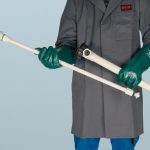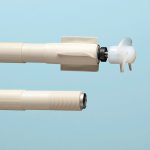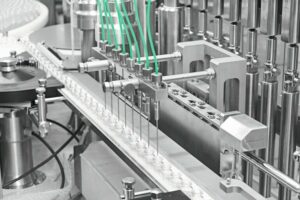Flux brought the first electric drum pump to market in 1950.
Mr. Hahn, what was the idea behind its development?
Klaus Hahn: Before that, drum pumps were always manually operated. This was both time-consuming and strenuous. Because of this, our company had the idea of combining drum pumps with an electric motor. Flux has traditionally had a high level of competence in the electric drives area, which is probably why we were able to come up with this particular invention. That’s how the world’s first electric drum pump came into being back in 1950. An explosion protected version followed in 1953. We were also the first supplier in the world to offer this product. In 1957, we then introduced the 400 series of pumps, which will celebrate its 60th anniversary this year.
How did your company gain its expertise in the electric drive technology field?
Hahn: Flux started out manufacturing electric motors for Progress vacuum cleaners, which at the time were made in Stuttgart.
Back to the 400 series. These are axial centrifugal pumps. What advantages does this type of pump offer users?
Hahn: These pumps can be used universally. However, their biggest advantage is that they work without pulsation, creating a very even flow.
Over the last sixty years, the company has built an extensive product family based on the 400 drum pump series. What was the driving force behind this family’s consistent expansion?
Hahn: That’s always been our customers, who continue to confront us with new pumping tasks they want to handle with the 400 series. For our engineers, this means the pumps regularly need to be adapted to new process conditions in a wide range of industries. And that’s how the first 400 series became a product family, which today comprises eight different drum and container pumps.
Could you give us a quick overview of the various pumps that are part of the 400 series?
Hahn: The 400 series basically includes drum and container pumps with or without a mechanical seal for vertical or horizontal pump delivery. They can be used for different kinds of media.
Could you also describe a few examples of pumps in the series?
Hahn: The F/FP 430 is a pump with a mechanical seal for vertical standard applications. It is available for submerged depths of up to 3 m. Its counterpart for standard applications without a mechanical seal is the F/FP 424. Both pumps have their own unique strengths and fields of use. The F 426 mixing pump is designed for conveying and mixing non-homogeneous media with a tendency to separate. And then I’d also like to mention the F/FP 425 residual drainage pump, whose strength is conveying especially expensive media.
Can you explain that please?
Hahn: This vertical conveying pump with a mechanical seal provides up to 99.98 % drum drainage. That means just 40 ml remains in a 200 l drum after the pumping process. A non-return valve that’s closed before the pump is removed makes this possible. The medium is prevented from flowing back into the drum.
Do pumps for hygienically sensitive applications in the food and pharmaceutical industries also exist in the 400 series?
Hahn: Yes, the F/FP 427 for example. This vertical delivery drum and container pump has a sealless design in the liquid area. It is manufactured from stainless steel and can be disassembled completely, which makes it very easy to clean. We also offer it in a 3A sanitary version for the American market.
Up to now, you’ve only discussed pumps for vertical applications. Could you please also describe one for horizontal delivery?
Hahn: The Miniflux container pump was developed for horizontal use on IBCs. Despite its extremely compact design, it achieves a strong flow rate.
As the examples you’ve mentioned indicate, the pumps in the 400 series are very well tailored to a wide range of tasks. This is due to their different seal designs and rotor types. What rotor versions does the portfolio include?
Hahn: Before I come to the rotor types, I’d like to say one more thing about the seal designs: all our plastic pumps with mechanical seals have a heart of steel. This is a steel pipe coated on the exterior with plastic in which the pump shaft is housed, with a mechanical seal on the bottom end. On the one hand, the steel pipe creates a defined position for the mechanical seal – even if the temperature fluctuates. On the other, it stabilises the travel of the pump shaft, which is a very important factor especially at submerged depths of over 2 m.
And why is the steel pipe coated with plastic on the outside?
Hahn: To create chemical resistance to the conveyed media.
Let’s get back to the rotors. What kinds of design are available?
Hahn: We equip our pumps with axial or semi-axial rotors, which are also called centrifugal rotors, depending on the customer’s needs.
When is which kind of rotor used?
Hahn: We recommend axial rotors for applications where a high delivery rate is desired. Semi-axial rotors are preferred whenever the medium needs to be conveyed over long distances at high pressure or if it has to overcome a big difference in height.
In which materials does Flux offer its 400 series drum and container pumps?
Hahn: That depends firstly on their resistance to the media to be conveyed and secondly on whether the pumps will be operated in explosion hazard areas. The spectrum of possible materials for components that come into contact with the product ranges from polypropylene or polyvinylidene fluoride to aluminium and stainless steel or Hastelloy C.
Are all pumps approved for use in explosion hazard areas?
Hahn: No. The F/FP 427 hygiene pump, which can be fully disassembled, and all plastic pumps like the F 430 PP 100/50 container pump, which is made of polypropylene, must not be used in explosion hazard areas. Apart from these, all other pumps in the 400 series and made of stainless steel or Hastelloy C have Atex approval.
Not even the best pumps can function without a drive. What options does Flux offer for the 400 series?
Hahn: Depending on the customer’s needs, the pumps either have an electric or a pneumatic drive. Of course, the highest demand is for electric drives and above all commutator motors.
Which Flux also manufactures in-house.
Hahn: That’s right. We manufacture them ourselves here in Maulbronn.
Why does the company make its own motors?
Hahn: For quality and flexibility reasons. Our customers value the high quality of our products. By manufacturing our own commutator motors and implementing our own accompanying quality management system, we can keep a handle on quality ourselves. In addition, we can react very flexibly to different country-specific requirements with respect to the voltage and frequency at which the motors can be operated.
Jürgen Rabenseifner: By producing our own motors, we’re better able to react to customer requirements. I’m thinking of one case we recently handled for customers from the Middle East. They were looking for an explosion protected pump unit that could be operated up to an ambient temperature of +60 °C. The Atex approval only covers a temperature range up to +40 °C. With this requirement in mind, we developed our explosion protected F 460 Ex commutator motor to handle the desired ambient temperature. Then we had PTB certify the entire pump unit, consisting of the F 460 Ex HT motor and the sealless F/FP 424 (HT) pump, in accordance with Atex requirements.
The 400 series also includes so-called pump sets. Mr. Rabenseifner, what are these sets exactly?
Rabenseifner: They’re pre-configured units consisting of a pump, motor, hose and pump nozzle. They offer two major advantages for users: We tailor all the components to the medium to be conveyed as well as to the application. Secondly, these units can be put into operation immediately.
Could you describe a typical example of how a 400 series drum and container pump is used in the chemical industry?
Rabenseifner: That’s quite difficult because these pumps are used in such a wide range of applications in that industry every day. One frequent use is delivering hazardous materials such as amines to a tank, then filling them into holding tanks. The FP 425 Ex S with a non-return valve is used for this purpose, for example. In conjunction with a flow meter, an overfill protection device and appropriate emission control equipment we can create a semi-automatic filling system that fulfils the highest safety requirements.
Online search: cpp0218flux
Hall 8.0, Booth E10
Author: Lukas Lehmann
Assist. Editor-in-Chief
„Our customers continue to confront us with new pumping tasks for the 400 series. That’s the driving force behind the development of these pumps.”








